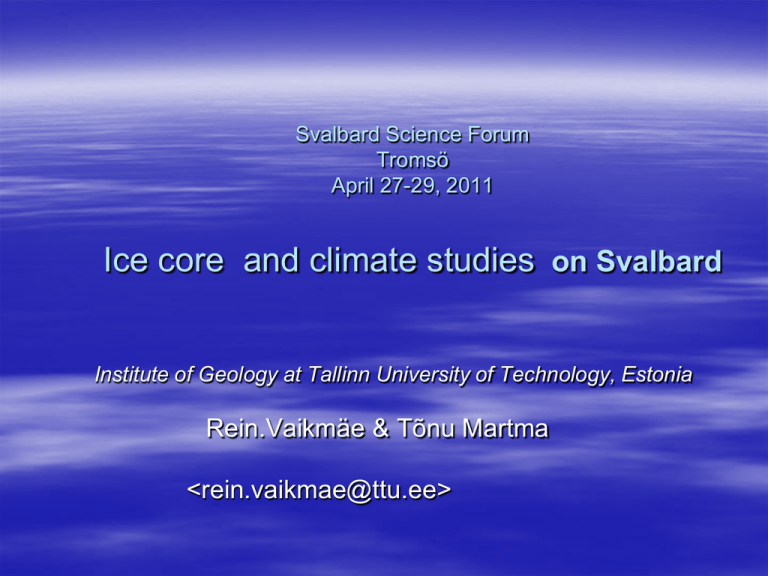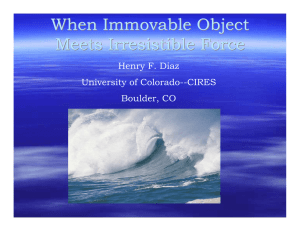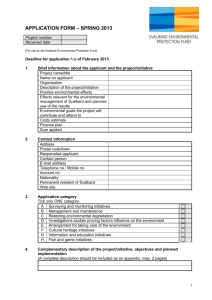Ice core and climate studies on Svalbard
advertisement

Svalbard Science Forum Tromsö April 27-29, 2011 Ice core and climate studies on Svalbard Institute of Geology at Tallinn University of Technology, Estonia Rein.Vaikmäe & Tõnu Martma <rein.vaikmae@ttu.ee> Outlines: Earlier studies (1975-2010) ESF SvalGlac Project Main research directions of the Department of Isotope Paleoclimatology, IG TUT Isotope-paleoclimatology, paleocryology and -paleohydrology; application of isotopic methods in Paleozoic stratigraphy, - climatology and - oceanology Laboratory environment Thermo Electron Corporation Delta Advantage mass-spectrometer for isotope analyses of light elements (H, C, N, O, S) Picarro Laser Analyser for O&H isotope analyses in water samples Quantulus liquid-scintillation counter and relevant sample preparation laboratory for radiocarbon dating ion chromatography OSL and EPR dating Lomonosovfonna 1976 Amundsenisen 1980 Amundsenisen 1980 Severnaja Zemlja 1979 icecore sampling LGM “Ledyanaya Gora” West -Siberia Ice- wedges (Kolyma riverbank) Antarctica Dome B δ18O ~ -22‰ O 1981 o 1985 1987 1975 GronfjordbreenFridtjovbreen 1976 Lomonosovfonna 1980 Amundsenisen 2005 1981 Vestfonna o 1976 1985;1987 Austfonna 1997 2009 o 1975 o 1980 1997; 2009 Lomonosovfonna 2005 Holtedahlfonna Scientific objectives The main goal has been to investigate and quantify the present and the past 800 years of climate by means of shallow and medium depth ice core records from Svalbard 20th century The last 600 years Main conclusions up to now With careful site selection and with detailed sampling Svalbard ice cores can provide important information on both local and regional climate variability in the Arctic “Austfonna crying” (Aftenposten, 04.09.2009) Main partners Norwegian Polar Institute Arctic Center, Rovaniemi, Finland University of Uppsala, Sweden Tallinn University of Technology University of Utrecht, Holland, University of Bern, Switzerland University of Groningen, Holland National Institute of Polar Research (NIPR), Japan University of Pennsylvania, USA http://svalglac.eu/ The main objectives to obtain a reliable estimate of the total ice volume stored in Svalbard; to estimate the recent past climate changes and mass balance rates of Svalbard; to improve the process understanding related to mass balance and ice dynamics; to model the expected response in surface mass balance and calving flux rate under different scenarios of climate change. The overriding goal is the knowledge and the quantitative depiction of the Svalbard glacier evolution model under the climate change condition. The Partner Countries The SvalGlac consortium consists of eight partner countries and five associated partner countries. Principal Investigators Poland: Jacek Jania (University of Silesia) - Project Coordinator Piotr Głowacki (Institute of Geophysics, Polish Academy of Sciences) Spain: Francisco Navarro (Technical University of Madrid) - Co-coordinator Sweden: Veijo Pohjola and Rickard Pettersson (University of Uppsala) Peter Jansson (Stockholm University) Germany: Dieter Scherer (Technische Universität) Matthias Braun (University of Bonn) Christoph Schneider (RWTH Aachen University) Austria: Friedrich Obleitner (University of Innsbruck) Estonia: Rein Vaikmäe (Institute of Geology, Tallinn University of Technology) Finland: John Moore (Arctic Center) Italy: Daniela Mansutti (Instituto per le Applicazioni del Calcolo, Council for National Research) Associated Partners Norway: Jon Ove Hagen (University of Oslo) Thomas V. Schuler (University of Oslo) Andreas Kääb (University of Oslo) Jack Kohler (Norwegian Polar Institute) Elisabeth Isaksson (Norwegian Polar Institute) Carl Egede Boggild (The University Centre in Svalbard) the Netherlands: Carleen Tijm-Reijmer and Michiel van den Broeke (Institute for Marine and Atmospheric Research) the United States: Regine Hock (University of Alaska) Russia: Andrey Glazovskiy (Russian Academy of Sciences, Institute of Geography, Department of Glaciology) China: Xiao Cheng (Beijing Normal University, College of Global Change and Earth System Science) ESF SvalGlac Thank you !




